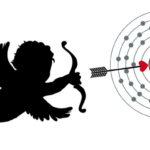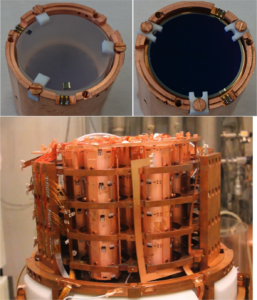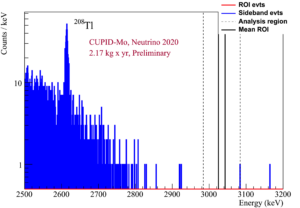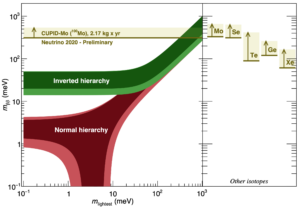
CUPID-Mo: a new world leading limit for neutrinoless double beta decay of 100Mo
Neutrinoless double beta decay (0νββ) is a crucial process in particle physics and cosmology. It can be conceived as an inclusive test of “creation of leptons” (leptons are produced with no counterpart in terms of antileptons, and lepton number violation occurs) and, more generally, as “creation of matter” (particles are produced with no counterpart in terms of antiparticles).
The observation of 0νββ is a big challenge: we need to find single events in a ton × year of exposure. Its signal corresponds to less than 10-13 Bq/g, while in normal life we are confronted with 15 Bq/banana! If from one side 0νββ is an extremely rare process, on the other one its signature is extremely clear and unambiguous: scientists need to find a peak in the spectrum of the total energy deposited in the detector by the two emitted electrons. The expected position of the peak is known with better than 0.1% accuracy.

Enriched Li2MoO4 crystal coupled to its Ge light detector (top); the CUPID-Mo detector installed inside the EDELWEISS cryostat at LSM (bottom). Credit: CUPID-Mo
The CUPID-Mo experiment, which has just completed the data taking at the Laboratoire Souterrain de Modane (France), is a demonstrator for CUPID, the next-generation upgrade of the first ton-scale cryogenic 0νββ-search, CUORE.
At the recent Neutrino2020 virtual conference, the Collaboration has presented a new world-leading limit for 0νββ decay of 100Mo, one of the most promising isotopes for this search (Poster).
CUPID-Mo is composed by an array of 20 enriched ~0.2 kg Li2MoO4 crystals corresponding to 2.3 kg of 100Mo. The detectors were operated at ~20 mK under the Frejus mountain at a depth of 4800 m.w.e. sharing the EDELWEISS dilution refrigerator.
The CUPID-Mo Collaboration managed to combine the scintillating bolometer technique with an appropriate choice of the nucleus and of the crystal to obtain the exceptional background noise rejection necessary to search for 0νββ of 100Mo with unprecedented sensitivity.
When a nuclear event occurs, the Li2MoO4 crystal undergoes an increase in heat. This tiny increase is detected by a temperature sensor. In addition to the temperature change, scintillation light is emitted by the crystal. This radiation is collected by a light detector. CUPID-Mo light detectors are made of high-purity Ge wafers with a diameter of 44.5 mm and 175 μm thickness, including a 70 nm SiO coating to increase light collection.
The advantage of this double readout is the discrimination, event by event, of decay types. We know from previous bolometric experiments that a large part of the background in the 0νββ comes from alpha decays. Thanks to a different light-output, it is possible to separate alpha from beta decay events.

Zoom of the background energy spectrum, we can see zero count in the Region of Interest. Credits: CUPID-Mo
In the presented analysis, we consider more than one year of data (2.17 kg × y exposure in Li2MoO4 corresponding to 1.2 kg × y exposure in 100Mo) acquired between March 2019 and April 2020.
With the rejection of alpha events of lower light output, we are able to perform the 0νββ search without any backgrounds in the region of interest. First, this means that thanks to the high efficiency of the bolometric technology we are able to set a new world leading limit for the half-live of 0νββ decay of 100Mo of 1.4×1024 y, better than the previous 1.1×1024 y. Moreover, the achieved suppression of background already exceeds the performance of the CUORE experiment and meets all requirements for the implementation of the CUPID-Mo technology in CUPID at much larger scale.

Effective Majorana mass as a function of the lightest neutrino mass. We can see the new limit obtained by the CUPID-Mo collaboration : with an exposure of only 1.2 kg x y in 100Mo, we are able to set a limit of mbb < (0.31-0.54) eV 90% c.i.
Limits obtained by other collaborations for other isotopes are also shown. Credits: CUPID-Mo
The CUPID-Mo experiment has completed a 3-week calibration campaign with an accelerator-produced short-lived source of 56Co to improve the understanding of the energy scale and resolution in the 0νββ decay region of interest. Several physics analyses will be performed in the coming months, along with a refined study of the background model.
Later this decade, the CUPID-Mo technology will be pursued on a large scale in the CUPID experiment, with about 1500 crystals installed at the Gran Sasso Laboratory in Italy in the current CUORE facility. CUPID will be at the forefront of 0νββ search.
The CUPID-Mo experiment brings together several European laboratories from France (IJCLab, IP2I-Lyon, IRFU/CEA, IRAMIS/CEA, Institute Néel, Université Paris-Saclay and Université Grenoble Alpes), Ukraine (KINR), Italy (INFN-Rome and INFN-Milano-Bicocca, LNGS, University of La Sapienza, University of Milano-Bicocca and University of Insubria) and Germany (KIT, TUM) and other international laboratories from the U.S. (LBNL, MIT, University of California and University of South Carolina), Russia (JINR, ITEP, NIIC) and China (Fudan University, USTC) .
Claudia Nones for the CUPID-Mo Collaboration
Further information:
- News item CEA IRFU: http://irfu.cea.fr/en/Phocea/Vie_des_labos/Ast/ast.php?t=fait_marquant&id_ast=4800
- New item Berkley Lab: https://newscenter.lbl.gov/2020/07/13/scientists-successfully-demonstrate-a-new-experiment-in-the-search-for-theorized-neutrinoless-process/
- Article on Futura Sciences (French): https://www.futura-sciences.com/sciences/actualites/physique-enigme-antimatiere-cupid-tentera-resoudre-decouvrant-neutrinos-majorana-55766/




